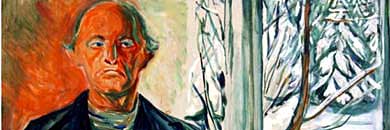Edvard Munch: Behind the scream, by Sue Prideaux
Fiends and foes of the artist of angst

To coincide with the exhibition of Munch's self-portraits at the Royal Academy, Sue Prideaux uses her part-Nordic origins to good effect in the first English-language biography of the artist, whose works hung in the home of her great-uncle, shipowner Thomas Olsen. The repressive yet assertive atmosphere of Lutheran Norway, as it worked free from Swedish rule, is vividly evoked. As child, Munch was denied emotional expression, told not to cry when first his mother then his sister died, for they had gone to a better life with God.
He grew a stiff, impassive shell, then rebelled in joyless bohemianism. In Oslo bars, Edvard mixed with nihilists, anarchists and satanists without espousing their creeds. In Paris, his art struggled for a way past impressionism, influenced by Gauguin to use colour and line for expression not depiction. He painted thinly, having a hatred of images trapped beneath gravy-like varnish. Critics mocked; impoverished relatives wondered why he did not use his talents more productively.
He was painting his soul - to convey inner anguish, in a post-Romantic rejection of bourgeois and high-art values. To the end of his life, he felt as if two vultures were tearing at his soul, not in the classic form of good and evil, it seems, but equal, opposing forces of despair and self-loathing.
To escape - and ironically to encourage - his demons, he lived on the edge, preferring drink to food, "fiends" to friends and faithless lovers to a loving wife. A sequence of women with advanced views shaped a turbulent private life during which he refused normal affections by reference to hereditary "taint" in the form of syphilis or insanity. However, echoes and foreshadowings of both Dorian Gray and Francis Bacon raise thoughts of a gay subtext to his relationships.
His magnum opus, The Frieze of Life, sets out a view of love, sexual disillusion and cruelty followed by sadness, anxiety, fear, crucifixion and drawn-out death. As themes, these are conventional enough, but the designs and handling make them modernist beacons of impressive power. Munch saw them as the children he had forsworn.
His disorderly life and inchoate images owed a great deal to alcohol. At one level, the shapeless figures and smudgy strokes look the work of an artist who could neither see nor hold a brush steadily. And the first half of his life story chronicles such intake of absinthe that one is astonished to find he lived to 80.
He seemed bent on indirect suicide, like Ibsen's Lovborg, unable to perform it heroically. Then, at 45, Munch saved himself. Hallucinating, paranoid, he went into rehab in Copenhagen and dried out. At the same time, he grew rich, as his works started to sell.
He settled on the edge of the Oslo fjord, living as a recluse, but creating obsessively; his house yielded more than 1,000 paintings, 4,000 drawings, 16,000 prints. Was there a cost to sobriety? He wrote that without anxiety and illness he was rudderless: "My sufferings are part of myself and my art." Prideaux's narrative grows less animated as his life quietens down. It ended during the Nazi occupation of Norway. Curiously, though his works were hung in the Degenerate Art exhibition of 1937, Goebbels was a fervent admirer. Munch's funeral was hijacked and swathed in swastikas. He had never expected to live so long.
Jan Marsh's latest book is 'Black Victorians' (Lund Humphries)
Join our commenting forum
Join thought-provoking conversations, follow other Independent readers and see their replies
Comments
Bookmark popover
Removed from bookmarks